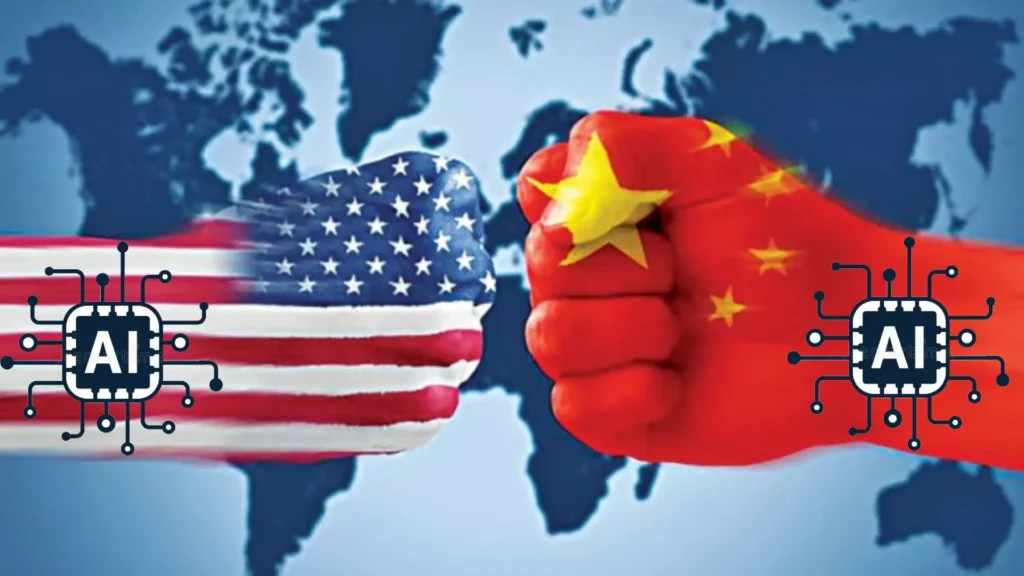China vs US in AI: The global tech ecosystem is advancing at an unprecedented pace, with the United States and China leading the charge. Both nations are making significant strides in areas like semiconductors and large software models. While the US maintains an edge in infrastructure, China is rapidly catching up in application speed, fostering a competitive environment that fuels innovation.
Table of contents
- The Rise of the E Large Model: A New Contender in AI
- The Challenges of the AI Landscape: Competition and Barriers to Entry
- Striking a Balance: Efficiency and Model Size
- The Future of AI and GPUs: Trends to Watch
- Safety and Regulation: Balancing Innovation and Ethics
- Conclusion: Embracing the Future of AI
The Rise of the E Large Model: A New Contender in AI
A major development in the AI landscape is the launch of the E Large model, a new AI model designed to compete on a global scale with industry giants like GPT-4. Developed by a relatively new company, the E Large model has already demonstrated performance comparable to GPT-4 in independent evaluations.
Key Features of the E Large Model:
- Global Reach: Engineered to support diverse applications worldwide.
- High Performance: Boasting capabilities on par with leading AI models.
- User-focused: Prioritizing a seamless and intuitive user experience.
The Challenges of the AI Landscape: Competition and Barriers to Entry
The AI industry is fiercely competitive, with substantial barriers to entry. Only a handful of companies globally, located primarily in the US, China, and a few other countries, have achieved high levels of performance.
Key Challenges for Newcomers:
- Resource Constraints: Limited access to advanced GPUs, essential for training large AI models.
- Cost Efficiency: The need to train models at a fraction of the cost of established competitors.
- Rapid Development: The pressure to achieve high performance despite resource limitations.
Striking a Balance: Efficiency and Model Size
Efficiency is paramount in AI development. While large models offer impressive capabilities, their size often makes them impractical for everyday use due to high latency and resource demands. To address this, companies are now focusing on:
- Model Variety: Developing models of varying sizes tailored to specific applications.
- Resource Efficiency: Optimizing performance while minimizing resource consumption.
- Deployment Practicality: Ensuring models can be easily and effectively used in real-world scenarios.
You May Also Like – Top 10 Technologies To Learn In 2024
The Future of AI and GPUs: Trends to Watch
The future of AI is likely to feature smaller, more efficient models that can be deployed locally. This approach reduces reliance on centralized resources and mitigates the rising cost and limited availability of high-end GPUs.
Key Trends Shaping the Future:
- Local Deployment: Enabling faster response times and improved performance.
- Resource Innovation: Developing new techniques for efficient model training and deployment.
- Scalability: Creating solutions that can adapt to a wide range of applications and user needs.
Safety and Regulation: Balancing Innovation and Ethics
Safety is a critical concern in AI development, particularly regarding the potential for misuse by malicious actors. Robust safety measures and regulations are essential, but a balance must be struck between centralized control and open-source, decentralized approaches.
Important Considerations for China vs US in AI
- Ethical Standards: Ensuring AI development aligns with diverse privacy and ethical principles.
- Open Source: Promoting transparency, collaboration, and innovation within the AI community.
- Regulatory Balance: Establishing regulations that protect users while fostering continued growth and development.
Conclusion: Embracing the Future of AI
The AI industry is poised for explosive growth, fueled by breakthroughs in model efficiency and practical deployment. Companies are continuously innovating to remain competitive, with a focus on user experience and scalable solutions. As the landscape evolves, continuous learning and adaptation will be crucial for those looking to thrive in this dynamic field.
Key Takeaways:
- The tech ecosystem is advancing rapidly, particularly in the US and China.
- The E Large model is a significant new player in the AI arena.
- Efficiency and practical deployment are key factors for the future of AI.
- The future of AI is likely to involve smaller, more efficient models.
- Safety and ethical standards are paramount in AI development.
By understanding these trends and developments, professionals and enthusiasts can position themselves to leverage the opportunities presented by the rapidly evolving AI landscape. The question remains: Can China’s AI technology truly compete with the US? The advancements and innovations we’re witnessing suggest that it can.

